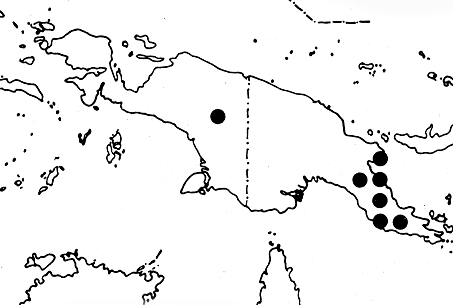
Distribution Map

Description (Barlow 1992)
Loranthus pachypus Burkill, Kew Bull. (1899) 109. - Amyema pachypus (Burkill) Danser, Bull. Jard. Bot Buitenzorg III, 10 (1929) 297. - Type: Guilianetti s.n. (holo K), New Guinea, Mt Scratchley, 3000-4000 m, 1896.
Amyema clavipes Danser, Brittonia 2 (1936) 132. - Type: Brass 4972 (holo NY; iso L 936,139497), New Guinea, Centtal Division, Mt Tafa, 2400 m, iv.1933.
For descriptions see Barlow, Austral. J. Bot. 22 (1974) 570, 582
under A. clavipes and A. pachypus. Amyema pachypus can
be identified locally by its combination of opposite bifacialleaves,
its umbel of triads with few, relatively thick rays, and its bracts
constricted below the apex but lacking a distinct dorsal protuberance.
The flower colour is described as pink to dark red.
The species occurs in the highlands of New Guinea (fig. 11; 32 collections seen) in subalpine vegetation from 2300 to 3800 m elevation. Recorded hosts include Dacrycarpus, Drimys, Podocarpus, Prunus, Rapanea, and Rhododendron. The subalpine species of Amyema in New Guinea are a closely related natural group, and intergradation between them apparently occurs (see notes under A. dilatipes). A geographic replacement pattern exists between A. pachypus and A. wichmannii (see note under A. wichmannii). For note on possible relationship with A. artensis, with which A. pachypus is sympatric but tends to replace at higher elevations, see there.
Barlow (1974) maintained A. pachypus and A. clavipes
as distinct although very closely related species, with virtually
identical areas and an altitudinal separation. Further study has
confirmed the altitudinal gradation in the characters used to
distinguish the taxa, which are mainly the length, thickness and
articulation of axis segments. However, they are probably segregates
from a single gene pool, and A. clavipes and A. pachypus
are therefore treated as conspecific, resulting in an entity
which is more concordant with patterns of variation in the genus.
Description (Barlow 1974) for Amyema clavipes Dans. Brittonia 2:132, illus. t. 1, d(1936); Blumea 3:43(1938); 3: 395 (1940). Type.-Papua, Central Div., Mt. Tafa, 2400 m alt., Brass 4972, Apr. 1938 (NY, holotype; L 936139497).
Glabrous or with the inflorescence bearing scattered short simple hairs. Leaves opposite; petiole distinct, flat above, 5-8 mm long; lamina elliptical to ovate, 4-6-(8) by 1.8-2.5-(4) cm, slightly lustrous above, dull below, gradually attenuate at the base, obtuse or rounded at the apex; venation pennate with all venation faintly visible.
Inflorescences solitary or few in the axils; peduncle slender (0.8-1.0 mm wide below, 0.5-0.8 mm wide above), 12-16-(20) mm long; rays usually 4 (rarely 3), thicker than the peduncle (c. 1 mm thick), spreading, 5-7 mm long; pedicels of the lateral flowers c. 3 mm long; bracts erect, acute, 1 mm long. Calyx barrel-shaped or slightly funnel-shaped; limb 0.3 mm long, minutely irregular. Corolla in the mature bud slender, clavate, 14-19 mm long, 4-merous. Anthers 1 mm long; free parts of the filaments 25-3 mm long. (Fig. 5, g.) Chromosome Number.- n = 9 (new record). Voucher: Barlow 1844.
Occurrence. Highlands of Eastern New Guinea from near Garaina to the eastern Owen Stanley Range (Fig. 2), 2380-3000 m alt.
Representative Specimens. EASTERN NEW GUINEA: Above Bakaia, c. 15 miles SE. of Garaina, c. 2600 and 2750 m alt., Hartley 12762 and 12745, 24.1.1964 (CANB; L; LAE). Mt. Albert Edward, ridge above Neon Basin, 3000 m alt., Barlow 1843 and 1844, 25.viii.1970 (AD; LAE); Main Ra. NW. of Gap, c. 2450 m alt., Carr 15227, 22.i.1936 (L); Mt. Maucao, 2900 m alt., Cruttwell 774, 23.i.1956 (K).
A. clavipes and
A. pachypus are very closely related, and have probably
differentiated altitudinally (cf. Danser 1938). The two have been
treated as distinct species in view of the several differences,
including those of length and articulation of the internodes,
leaf size, venation, leaf apex, length and thickness of the inflorescence
parts and anther length, all of which indicate that the two forms
have attained a significant level of isolation. See notes under
A. corniculatum and A. wichmannii.
Illustrations
|
Above: Amyema clavipes. Portion of inflorescence. From Barlow (1974).
Right: A. clavipes. Twig with leaves and inflorescence in bud. From Danser (1936, Brittonia 2: 131-134). |
 |
A. pachypus from Barlow (1974)
Description
Amyema pachypus (Burk.) Dans. Bull. Jard. bot. Buitenz. 10: 297 (1929); 11: 341 (1931); Loranthuspachypus Burk. Kew Bull. 109 (1899). Type-Mt. Scratchley, 3000-4000 m alt., Guilianetti sn., 1896 (K).
Glabrous and somewhat glaucous or the infiorescence and flowers sparsely to densely brown-tomentose. Stems robust, articulate at the nodes; internodes short (rarely exceeding 3 cm). Leaves opposite; petiole 2-7 mm long; lamina oblong to obovate, 2.5-4.5 by 1.2-2 cm, attenuate at the base, thick, rounded at the apex but sometimes with a small mucro; venation pennate, indistinct. Inflorescences solitary or few in the axils; peduncle 8-11 mm long, 1-1 5 mm thick; rays 3-5, mostly 4, thicker or as thick as the peduncle, cigar-shaped and strongly articulate, 355 mm long; pedicels of the lateral flowers similar to the rays, 2-4 mm long; bracts acute, 1 mm long, with a rounded dorsal protuberance. Calyx cylindrical to barrel-shaped; limb 0.3 mm long, obscurely toothed. Corolla in the mature bud very slender, clavate, c. 15 mm long, 4-merous. Anthers oblong, c. 0.5 mm long; free parts of the filaments c. 2 mm long. Stigma hardly wider than the style. Fruit barrel-shaped, not seen mature.
Occurrence. Eastern Highlands of New Guinea, from Mt. Amungwiwa, south of Wau, to Wharton Range (Mt. Albert Edward) (Fig. 6). Alpine communities above 3000 m alt.
Specimens Examined. EASTERN NEW GUINEA. Mt. Amungwiwa, S. of Wau, 3480 m alt., Womersley NGF 17933, 3.xi.1963 (LAE; CANB; K); Mt. Dickson, Goilala Subdist., 3520 m alt., Hartley 12961, 10.ii.1964 (CANB; L); Mt. Albert Edward, 3500 m alt., Brass 4378, May-July 1933 (L); Mt. Albert Edward, S. slope, 3060 m alt., van Royen NGF 30072 and 20095, 22.i.1965 and 23.i.1965 (LAE).
See note under A. clavipes.
Photographs
Amyema pachypus
updated 18 January 2007